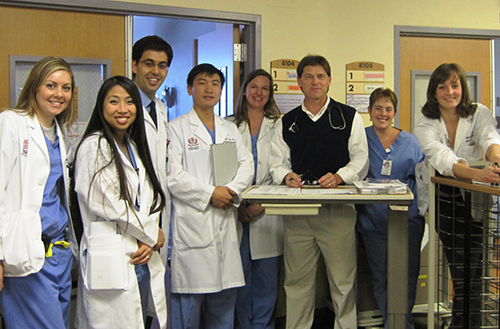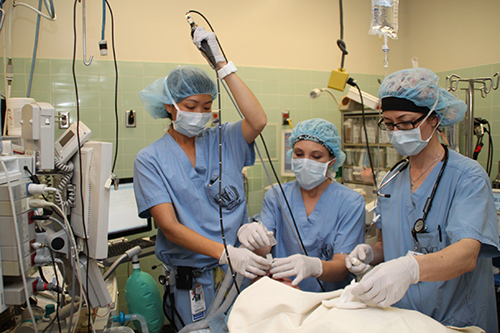We’re Stronger Together
With your help, we can make ambitious innovations in clinical care and education for our community.
The first 12 months of training in the combined program will be spent as a PGY-1 (Program Year-1) resident in internal medicine. During PGY-2, the resident will complete 12 months of rotations in anesthesiology. The third through fifth years will consist of 6 months per year in internal medicine and 6 months per year in anesthesiology. Opportunities in both laboratory and clinical research are plentiful. In addition, clinical and research efforts focusing on population health, organizational quality improvement, and patient safety will be encouraged. Integrated throughout the curriculum will be continuity clinic experiences (130 distinct half-day outpatient sessions during residency), as well as experiences in simulation, critical care medicine, career development, physician leadership, perioperative care, and basic principles of health management, and hospital administration.

PGY-1 is designed to provide experiences that enable the trainee to make the transition from medical student to clinically competent physician. During this first year, the resident will receive exposure to a variety of inpatient and ambulatory experiences throughout general internal medicine and the subspecialties of internal medicine. Rotations in this year are based on a calendar month. PGY-1 residents will also attend a continuity clinic one half-day per week. PGY-1 residents spend approximately 4 months in general in-patient medicine wards, 2 months in critical care, and 6 months in other rotations, including emergency medicine, geriatrics, neurology and an elective month. Inpatient experience is predominantly scheduled on the general medicine and subspecialty wards at Loma Linda University Medical Center (LLUMC) and at the Loma Linda Veteran Affairs Hospital (LLVAH). Ambulatory experience is provided through ambulatory and elective rotations.
PGY-2 features instruction in the basic techniques and fundamental aspects of anesthetic care with clinical rotations at LLUMC and affiliated institutions, LLVAH, and Arrowhead Regional Medical Center (ARMC). Each of the training facilities offers clinical exposure to cases unique to the patient population served. The resident will spend one month in the preoperative evaluation (PATS) clinic, one month in a pain management clinic, and one month in the neurologic surgical-medical intensive care unit. Experiences in Simulation training will be provided during this year. Residents will be expected to have identified an educational project at this stage of training; projects focusing on health care safety and quality will be encouraged.

The anesthesiology portion of PGY-3 includes clinical experiences in the subspecialty disciplines of anesthesiology, including rotations in pediatric anesthesia, cardiac anesthesia, obstetrical anesthesia, critical care, neuroanesthesia, pain management, and regional anesthesia, and perioperative care coordination. The internal medicine portion of the PGY-3 year includes rotations in ambulatory medicine (LLVAH), general inpatient internal medicine, gastroenterology, and endocrinology. Experience in palliative medicine will be available during this year of training. Residents will continue work on their educational projects.
In PGY-4, residents will spend 6 months of anesthesiology completing the required two-months of subspecialty anesthesiology experiences in pediatric anesthesia, cardiac anesthesia, obstetrical anesthesia, critical care, acute perioperative pain management, and neuroanesthesia. Additional experiences will be gained in postoperative anesthesia recovery (PACU), outpatient anesthesia, and in anesthesia for procedures in non-OR alternate sites. Six months of the training during this year will be spent in Internal Medicine, with rotations in the coronary care unit (CCU), ambulatory medicine, hematology-oncology, pain management, and elective rotations. Emphasis will be placed in the areas of outpatient chronic disease management, patient counseling, health maintenance, and disease prevention.

The final year of training includes six months of anesthesiology training in advanced clinical experiences including anesthesia subspecialties, related areas, or research. No single subspecialty, excluding critical care medicine, will exceed six months. Graded clinical independence will be encouraged during this year, with clinical material selected that best challenges the resident’s ability to diagnose, treat, and manage patients throughout the perioperative continuum of care. The resident will be given opportunities to develop and coordinate perioperative care plans utilizing a “perioperative surgical home” model. The final six months of Internal Medicine training will include additional experiences in infectious diseases, rheumatology, in-patient internal medicine, ambulatory medicine, and elective time in which the resident may choose among a variety of medical subspecialties. The ambulatory experiences will focus around a variety of subspecialties (e.g. neurology, dermatology, office gynecology, psychiatry, ophthalmology, sleep medicine, and rehabilitation medicine).
By combining the disciplines of anesthesiology and internal medicine into one integrated training program, with emphasis placed upon acquiring knowledge of important health care principles such as patient safety, chronic care coordination, perioperative medicine, physician leadership, and organizational management, the graduate will be uniquely trained to assume a significant physician leadership role early in their career.
With your help, we can make ambitious innovations in clinical care and education for our community.